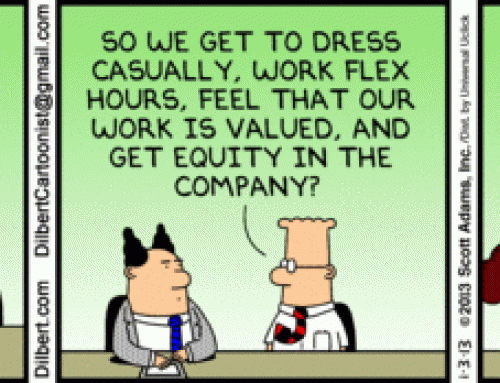Have you ever seen a vendor in action? The way they call out telling people what they are selling, the way that they are so persistent when they get a lead and the way that they are friendly to everyone that passes by. You would think that they have degrees in business judging by the way that some of them operate but as you might know a significant portion of them did not even make it into high school. Then you have your employees with their diplomas, MBAs and the likes. Some of them act like they are not educated by slacking on the job and not doing things right. Let me talk a little about why I think that some vendors are better at their work than some employees.
The Bottom Line
- A vendor’s performance is directly linked to their bottom line and this impact usually occurs on a daily basis in terms of the money that they take home
- If the vendor does not make money he or she will not be able to pay their bills or to sustain their families among other issues
- Some employees do not see things this way. They do not feel like their behavior will make much of an impact on their salaries, wages and future employment prospects because honestly, it usually does not
- The result is they do not put much effort as turning up at work is a guarantee that they will get paid
How to solve this problem:
Link performance to the employee’s bottom line by:
- Providing incentives for those who go beyond the call of duty e.g. financial incentives like bonus payments, extra off days, flexible working hours for a certain period etc.
- Give employees fixed contracts whose renewal will depend on their performance over a certain review period
- Ensure that the performance review process is clear and fair. Employees should be involved in the creation of the review framework to ensure that there is buy in to the process
- Plot a clear career path for the employee in the organisation (and even outside the organisation) and show them how performance will get them there. Create a competitive atmosphere by showing employees their prospects for promotion and the other employees that they have to beat in order to get that position.
The Bigger Picture
- A vendor has the big picture of where they are going with their business. They might be hoping to move from the streets and open a shop. As a result they know how everything they are doing impacts their vision.
- A vendor knows that every customer that they meet can help to make or to break their dreams. This is seen in the way that some vendors treat their customers, with care and respect.
- An employee often does not even know why they are doing what they are doing were the organisation is concerned. They do not know how their actions influence the direction and future of the organisation
- Most employees view their work as an activity that pays their bills and nothing more than that. To them there is a ‘them and us’ relationship with the employers
How to solve this problem:
- A lot of effort should be made to make employees understand their role in the firm and how it contributes to the bigger picture. This should be documented and given to each employee with reviews being made together with the employee periodically in order to ensure that momentum is maintained in the exercise
- Top management and line management should give employees insights into the firm’s strategies and how they can contribute to the achievement of objectives. They should do more than just spell out the firm’s mission and vision. Even more importantly employees should, at some level be used as sounding boards on strategy or should be asked to contribute ideas. This will ensure that there is buy in from the employees
- The firm should actively offer its employees shares in the organisation. Preferably the shares could be priced a little lower or could carry a slightly bigger dividend when one is an employee. Such a move will create some form of motivation for the employees to look at things from a higher level. It will make them want to contribute more as they will also benefit from their increased level of effort
Harmony
- A vendor represents all the ‘departments’ in his or her operation. He is the accountant, the human resources practitioner and the general hand among other functions. The result is that he or she knows how everything works and as a result there is harmony across all the functions
- When there is harmony activities are synchronized well with efficiency and quality being the direct result. The vendor can thus put more effort in his or her work as less energy is spent haggling with other people
- A lot of organisation’s departments are fragmented and you will find situations where people from different departments either do not get along or fight for resources among other problems. You will find situations where employees do not put a lot of effort in issues that they believe should sit with another department which goes against the whole idea of having a holistic approach to business
How to solve this problem:
- Harmony can be induced by making harmony a performance issue. A simple way of doing this is by creating service level agreements (SLA) between departments. The way these work is that when, for example, an employee opens a ticket with a support department the SLA stipulates that the support personnel should provide a solution within a certain amount of time. The SLA is then incorporated into the performance contract of both the employees involved in the transaction ensuring that they will put maximum effort in their work
- Hold inter-departmental workshops or sporting activities were people will get to interact sharing their views on various issues. Identify the pain points and create action plans that will lead to the creation of an environment that will be conducive to corporation and team work. Employees will put more effort in their work as feeling like you are part of a cause serves as a motivator.
As you can see vendors put more effort in their work and are thus ‘better’ than employees as they have a sense of ownership and belonging when they work. They see how various activities are intertwined and how they directly affect their bottom line. On the other hand some employees have a clouded or blinkered view of things and the result is that they put less effort on the job as the stakes seem lower to them. This can be reversed however and for more information on this and other business related issues contact me so that we can discuss. Share this article with at least 5 people and stand to get a free diagnostic consult courtesy of Plexis Strategy.
Thanks
Ruvimbo







Leave A Comment